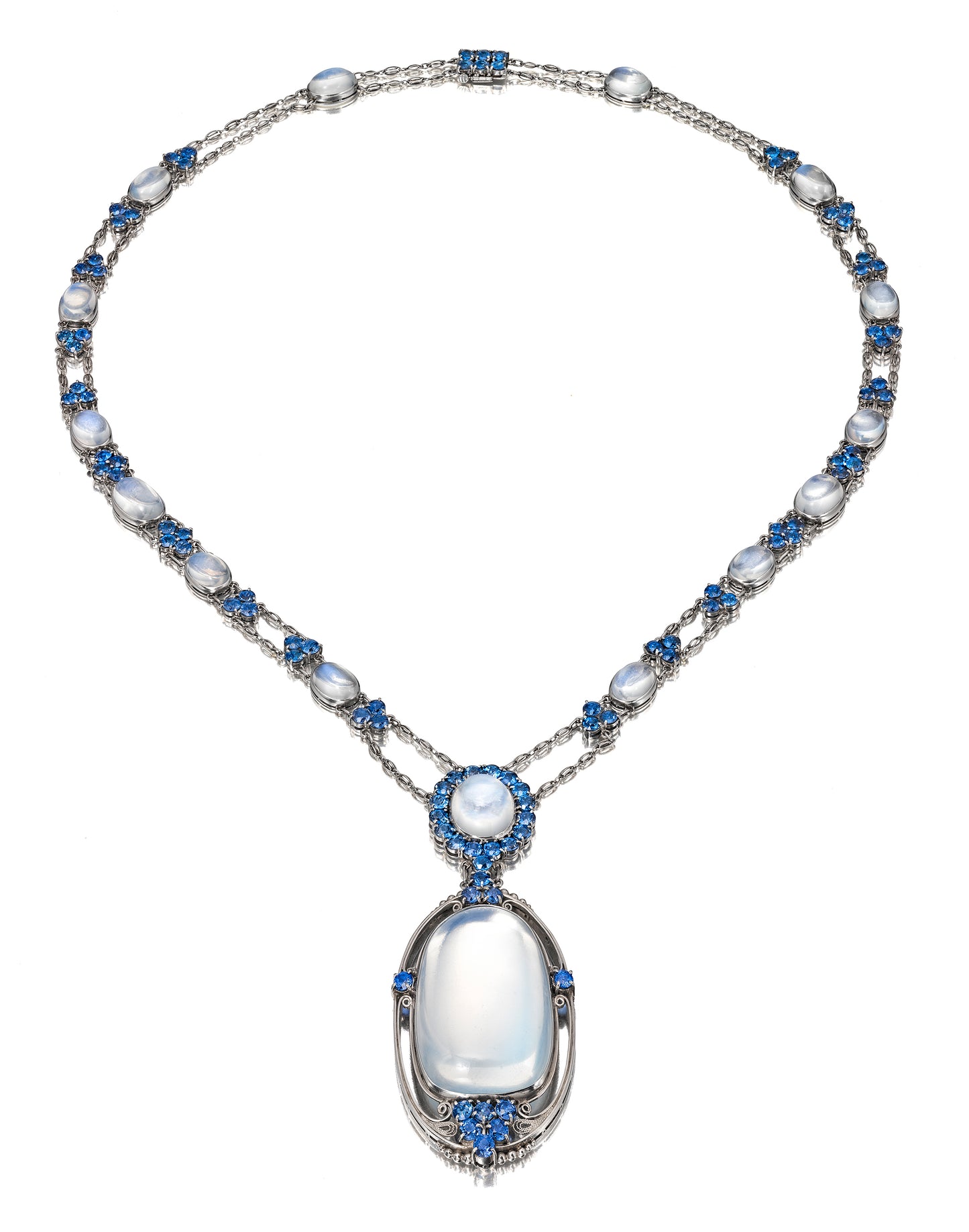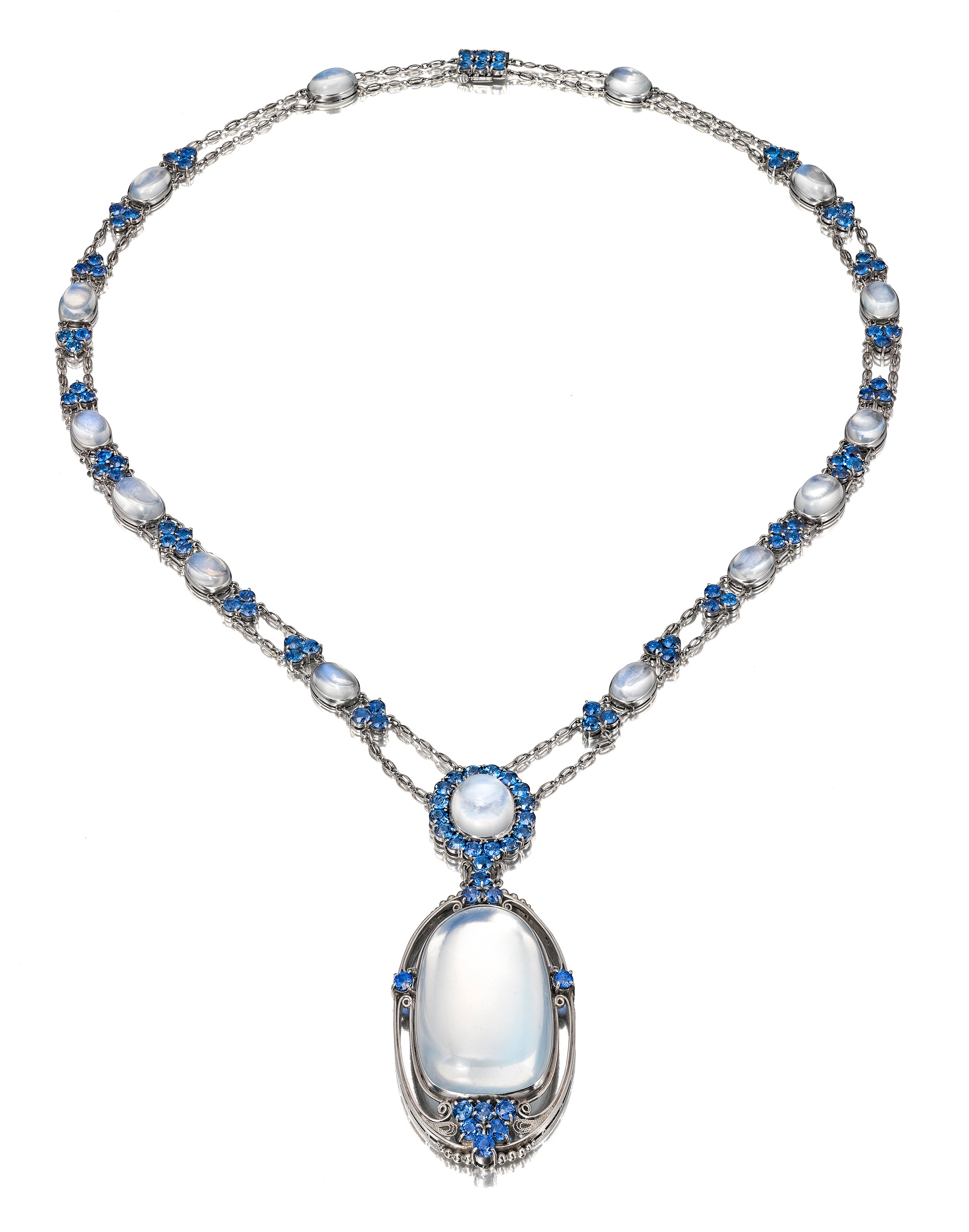MOONSTONE AND SAPPHIRE NECKLACE DESIGNED BY LOUIS COMFORT TIFFANY FOR TIFFANY & CO., NEW YORK, CIRCA 1915
MOONSTONE AND SAPPHIRE NECKLACE DESIGNED BY LOUIS COMFORT TIFFANY FOR TIFFANY & CO., NEW YORK, CIRCA 1915
SOLD
An necklace composed of an openwork pendant set with a cabochon moonstone encircled by a wire frame accented with Montana sapphires and suspended from another cabochon moonstone encircled by Montana sapphires, the pendant suspended from a chain composed of cabochon moonstones spaced by Montana sapphire trios; mounted in platinum and gold
- 16 cabochon moonstones
- 98 Montana sapphires
- Signed Tiffany & Co.
- Chain: 22 inches, pendant: 3 × 1 1/4 inches
Additional cataloguing
Literature
- cf. Duncan, Alastair. The Louis C. Garden Museum. Woodbridge, Suffolk: Antique Collector’s Club, 2004, pp. 498–499.
- cf. Loring, John. Louis C. Tiffany at Tiffany & Co. New York: Harry N. Abrams, Inc., 2002, pp. 74–75.
- cf. Zapata, Janet. The Jewelry and Enamels of Louis Comfort Tiffany. New York: Harry N. Abrams, Inc. 1993, pp. 109, 116.
Biography
Founded in New York City in 1837 by Charles L. Tiffany and John C. Young, Tiffany & Co. would become one of the foremost jewelers and silversmiths in the nineteenth and twentieth centuries, winning awards at international expositions. Tiffany’s son, Louis Comfort, created notable Art Nouveau leaded glass lamps, stained glass windows, and Favrile glassware. In 1902, he began making jewelry at Tiffany Furnaces and in 1907 this department became part of Tiffany & Co. From this date until it closed in 1933, all of his jewelry was produced in the jewelry department and bears the Tiffany & Co. stamps. Today, Tiffany & Co. operates stores in all major cities worldwide.
Significance
In 1902, at the height of his design career, Louis Comfort Tiffany turned his genius to designing jewelry. Surrounding himself with a small group of select craftspeople (many of them women), and collaborating with Tiffany & Co.’s preeminent gemologist, George Kunz, Louis began creating art jewelry that was unlike anything that had been seen before. This long necklace, an elegant cascade of American gems, has flowing lines and disparate blues that display Louis’s formal artistic training as a classical painter. The fierce blue of the Montana sapphires (a stone with a unique geologic origin rendering them nearly free from inclusions and almost uniform in crystalline shape) is softened by the azure sheen of the moonstones. Since Montana sapphires maintain their brilliant hue in artificial light, these colors are equally stunning in evening light as in daylight. The muted silvery sheen of the delicate platinum mount frames this expression of the blue color spectrum.
The structure of the necklace displays many signature elements of Louis’s work. Slight but purposeful asymmetries reflect the ideal that beautiful forms are not achieved by machine-like precision. Each bezel was handmade to fit the shape of the individual moonstone cabochons, with their full, slightly irregular domes and outlines. The mount itself, composed of emblematic wirework curlicues and delicate graduating applied beads, is a technical achievement in platinum, a difficult and demanding metal, which has rarely been worked with such delicacy. This necklace has the unusual element of elongated oval wirework beads, which give the impression of substance and volume, when in fact they are composed more of air than platinum. In this piece, Tiffany celebrated platinum’s great tensile strength that serves to render the mount practically insubstantial. The apparent simplicity of the necklace is the result of multiple contrasting design elements brilliantly harmonized.
This important Louis Comfort Tiffany jewel, rich in subtle coloration, superior in craftsmanship, and original in design, is an American masterpiece. Rare and important it represents a significant contribution to the art of jewelry from a genius who spent his life, as he said, “in the pursuit of beauty.”



